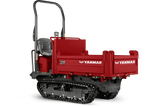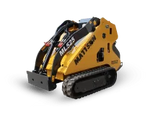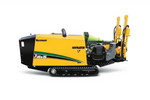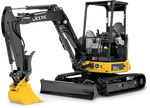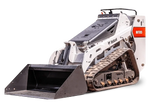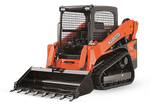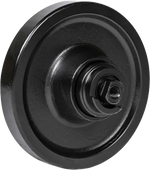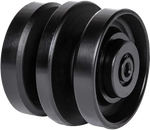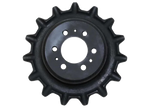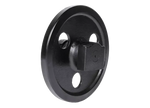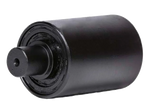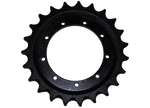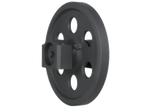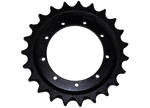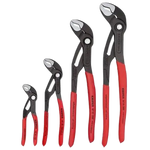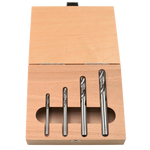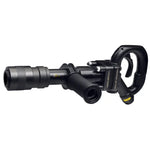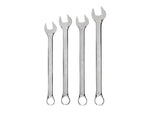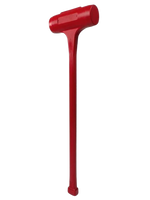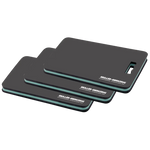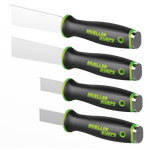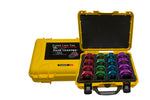Featured Products
John Deere 333G Compact Track Loader Repair Guide
Written by Luis Montes Updated On March 28, 2025

At Fortis HD, we aim to support machine owners and operators in several ways, from offering them high-quality undercarriage replacement parts and heavy equipment tools to sharing our expertise and knowledge in machinery-related topics.
With our John Deere 333G repair guide, you’ll troubleshoot problems related to the engine, electrical and hydraulic system. You’ll find all sorts of possible problems, from the simplest to the least likely, that are harder to verify.

Table of Contents
Engine Problems
Engine Will Not Start
Let’s start with an odd and one of the easiest issues to fix in this guide: the park brake doesn’t engage. Press the engine start switch on the sealed switch module (SSM).
Next, check if there’s fuel in the tank. Add the correct fuel and bleed air. Do the following to purge air out of the system:
- Park the machine on a level surface.
- Make sure the fuel tank is full.
- Open engine cover. See Opening and Closing Engine Cover.
- Remove the left engine side panel. See Engine Side Panels.
- Check that the fuel shutoff valve is in the ON position.
- Turn the switch power ON. The electric low-pressure fuel pump will start to bleed air.
If fuel is in the tank, first check that the fuel shutoff valve is open. If so, you may not be using the correct fuel type. Drain the fuel, change the primary fuel filter and water separator, and refill with the appropriate fuel:
- #1 Diesel (winter diesel) has a low viscosity. It prevents the fuel from thickening and gelling.
- #2 Diesel 2 is the standard fuel for most diesel engines.
- Biodiesel—concentrations above B20 can harm the engine’s emission control systems and should not be used.
- Renewable diesel—Renewable diesel that meets EN 590 or ASTM D975 is acceptable for all percentage mixture levels.
Another reason for the engine not starting is clogged fuel filters. Replace the primary and final fuel filters.
Air leaks (AKA vacuum leaks) on the suction side of the fuel system can also cause an engine start failure. Check for bubbles in the fuel filter to discard if your problem is an air leak. There are at least two ways to spot these leaks
- Pumping smoke into a vacuum line.
- Use starter fluid, a propane torch (unlit!), or a carburetor cleaner on vacuum lines and the intake manifold. Spray just a squirt of any of these products, and when you find the vacuum leak, you’ll see a spike in RPM, or the engine will stall. Precautions: check your ignition system first (sparks) to prevent catching on fire, and don’t do it when the engine is hot).
When the cranking speed is too slow, to the point that the engine won’t start, check the battery’s connections and voltage. A faulty battery connection can also affect the sealed switch module (SSM), keeping you from starting the engine. If the battery’s connections are good, look for a blown fuse (try with the F7 in the right-side fuse block).

Lastly, check the starter relay and its connections. If everything looks good, your best bet is to change the starter.
Engine Surges, Stalls, or Misses
The fuel you’re using might be incorrect or contaminated. Some signs of contamination are cloudiness (water contamination), dark color (oxide or sludge contamination), slime or gel-like (bacteria or fungi contamination).
Drain the fuel, change the primary filter, and bleed the air out of the system.
Sometimes, the solution is as simple as replacing the primary and final fuel filters or bleeding the fuel system.
The lack of air entering the engine and/or the fuel tank can also cause the engine to surge or stall.
Replace the primary engine air filter and check the condition of the secondary filter. The inner air filter only needs to be changed every third primary filter replacement or if a visual inspection indicates it.
A word of advice: Before wiping the inside of the housing, install the inner filter to prevent dust and debris from entering the system.

Listen for a hissing sound when removing the fuel tank cap to confirm that the fuel tank breather is causing your engine problem. If so, change the breather.
What causes the hissing sound? As your machine consumes fuel, the breather allows air to enter the tank, preventing a vacuum. When the breather is restricted or clogged, a vacuum builds up inside the tank as the fuel level drops. Removing the cap suddenly equalizes the pressure, causing the hissing noise.
Engine Overheats
Once more, the cause could be a restricted air filter.
Next, check the engine oil and coolant levels. The problem might be an incorrect coolant mixture if they are within the proper levels. Replace the coolant.
John Deere recommends using the John Deere COOL-GARD™II or John Deere COOL-GARD II PG coolants.
Check the different concentrations and their protection limits in the following table:
| COOL-GARD II pre-mix | Freeze Protection Limit |
|---|---|
| COOL-GARD II Water-Base | 0°C (32°F) |
| COOL-GARD II 20/80 | -9°C (16°F) |
| COOL-GARD II 30/70 | -16°C (3°F) |
| COOL-GARD II 50/50 | -37°C (-34°F) |
| COOL-GARD II 55/45 | -45°C (-49°F) |
| COOL-GARD II PG 60/40 | -49°C (-56°F) |
| COOL-GARD II 60/40 | -52°C (-62°F) |
If you choose John Deere COOL-GARD II Concentrate, do not use less than 40% or greater than 60% concentration of coolant. Less than 40% gives inadequate additives for corrosion protection. Greater than 60% can result in coolant gelation and cooling system problems. Water quality is also important when diluting concentrated coolant. Use Deionized or demineralized water.
For ethylene glycol or propylene glycol base coolants other than John Deere brand, make sure they meet these specifications (for diesel engines):
- Are nitrite-free.
- Are formulated with a 2-ethylhexanoic acid (2-EHA) free additive package.
- Coolant concentrate meeting ASTM D6210 requirements in a 40—60% mixture of concentrate with quality water intended for a 50/50 concentrate.
Two easy-to-spot reasons for overheating are a loose or damaged accessory drive belt or a loose surge tank cap.
So either tighten the surge tank cap and/or check for damages on the belt, like cracks at the bottom of grooves and fraying on the edges.
Another cause for an engine to overheat is debris buildup, not only in the radiator but in the other components of the cooling package. Clean the debris from the cooling package, which comprises the following:
- Radiator.
- Hydraulic oil cooler.
- Charge air cooler.
- Fuel cooler.

Besides the above, consider if you are pushing the crap out of your 333G and take it down a notch to reduce the load on the engine.
Electrical System
Park Brake Will Not Disengage
The problem here is that the interlocking seat bar switch isn’t activated. To fix it, lower the seat bar. Sometimes, you must raise and lower the bar to re-activate the seat switch and disengage the park brake.
Park Brake Will Not Engage
On the other hand, when the park brake doesn’t engage, it’s because the sealed switch module (SSM) isn’t receiving power. Check the fuse and battery connection.
Starting Motor Will Not Turn
Again, check for a blown fuse.
Next, check the battery’s voltage, clean corrosion, and/or tighten cables as necessary.
Take a look at the electrical connections at the starter or its relay.
If the problem persists, the next step is to replace the starter.
Engine Cranks Slowly
Since we are troubleshooting electrical problems, we should check the battery voltage and look for loose and/or corroded cables and connections.
However, another reason for a slow-cranking engine can be related to the engine’s oil viscosity, especially if starting in a cold weather season. Drain and refill the engine with the correct oil.
To minimize the effect that cold weather may have on the starting and operation of an engine, use seasonal-grade viscosity engine oil based on the expected air temperature range, according to the following chart:

John Deere recommends using its Plus-50™ II engine oil for optimum starting performance. If you prefer other brands, ensure they meet one or more of the following specifications:
- API Service Category CK-4.
- API Service Category CJ-4.
- ACEA Oil Sequence E9.
- ACEA Oil Sequence E6.
In any case, DO NOT use engine oil containing more than 1.0% sulfated ash, 0.12% phosphorus, or 0.4% sulfur.
If all of the above is in order, check/repair/replace the starter.
Battery Will Not Charge
Let’s start with the easiest: you either must replace the battery or have some cables and terminals corroded.
If everything is good with your battery, then you are idling excessively or have one of the following alternator issues:
- Since the alternator’s output depends on the engine’s RPMs, it won’t produce enough power at low engine speeds. A clogged fuel or air filter is the most likely and easiest to fix.
- The accessory drive belt is loose or damaged.
- You must repair or replace the alternator.
Lights Do Not Work
Check the bulb connection or replace it as necessary.

Otherwise, inspect the F6 fuse inside the right-side fuse block and replace it if blown.
Battery Voltage Indicator Remains on With Engine Running
When the battery input is low, the voltage indicator will remain on. Check the battery voltage and charge as necessary.
As in the previous section, a faulty alternator could be the source of the problem. Check the condition of the accessory drive belt and if your alternator needs repair or replacement.

Hydraulic System
Boom and Bucket Will Not Move
As part of the John Deere 333G’s start-up safety features, the hydraulic functions will be deactivated unless you do the following:
- Move the joysticks to the neutral position.
- Lower the interlocking seat bar to activate the seat switch.
- Desiengage the park brake.
Excessive Pump Noise
Check for the following three possible reasons:
- A low hydraulic oil level.
- A suction line is restricted.
- Air leaks at the pump inlet line fittings.
A low hydraulic oil level will cause the pump to struggle to maintain proper pressure. It will also reduce the system’s ability to dissipate heat, causing the oil to overheat and change viscosity.
On the other hand, air leaks and restrictions in the suction lines will cause aeration (foamy or milky hydraulic fluid) and cavitation (formation and collapse of vapor bubbles), which reduce the system’s ability and damage its components.
Check your hydraulic oil level, change hoses as necessary, and check/tighten the hydraulic connections.
Slow Hydraulic Function
Besides causing knocking or whining noises within the pump, a low hydraulic oil level and air leaks at the pump inlet line fittings can slow the hydraulic functions. Check the oil level and the hydraulic connections.
If the problem is air leakage, the hydraulic oil is likely aerated. Drain the hydraulic oil and refill it with fresh oil.
Next, inspect and tighten the fittings of the cylinders, hoses, and lines.

A restricted hydraulic and/or hydrostatic oil filter can also be one of the reasons. Look for the following amber indicator light on the operator’s station monitor.

Several operational reasons might also be slowing down hydraulic functions:
- Boom or bucket overloaded.
- Cold oil.
- Low engine speed.
- The auxiliary hydraulic roller is locked in the detent position.
First, consider if you are overloading the equipment and lighten the loads. Exceeding the machine’s capacity slows hydraulic functions due to heat buildup and activation of relief valves or load-sensing controls.
Extreme cold weather increases oil viscosity. To prevent damage to hydraulics and engine in temperatures below 0°C (32°F), run the engine at slow idle for 10 minutes before operating controls.
The engine drives heavy equipment hydraulic pumps. Fewer engine RPMs cause the pump to produce less flow, reducing the hydraulic fluid needed for system operation. To correct this, increase the engine speed.
If you’re using a roller attachment and have it locked in the detent position, return it to the neutral position to increase the flow to other functions.
However, when the problems are mechanical, such as stuck pivot pins or bent/damaged cylinder rods, contact an authorized John Deere dealer or a professional technician, such as those at Tekamo HD.
Machine Loses Power
Once again, the lack of proper maintenance is the primary cause of losing power. Check the following:
- Low hydraulic oil level.
- Restricted filters for:
- Fuel.
- Hydraulic oil.
- Hydrostatic oil.
- Engine air.
Hydraulic System Overheats
Right off the bat, check the oil level.
Another reason for overheating is a clogged oil cooler. Use compressed air to clean the fins. It’s a straightforward task.
Machine Will Not Move
Check if the park brake is engaged. If so, press the park brake switch on the sealed switch module (SSM).
Machine Mistracks
Your John Deere 333G tracks probably don’t have the same sag. Adjust the track tension.

To check and adjust the track tension:
- Park the machine on a level surface.
- Raise boom.
- Extend bucket cylinders to place the bucket in full dump position.
- Lower the boom to the lowest position (until the boom hits the stops) to raise the front of the machine off the ground.
- Engage park brake.
- Turn the engine off.
- Push bogie axle (1) against frame. Ensure the bogie axle contacts frame as shown.
- Measure distance (2) from the bottom of the third roller from the rear of the machine to the top of the track. The bottom of the rollers should not be touching the track.
- The track sag distance must be between 2.00—2.50 in.
- If the track sag is not within specification, remove cap screws (3) and track adjuster cover plate (4) on the track frame.
a. To decrease track sag, add grease to the track adjuster cylinder through grease fitting (5).
b. To increase track sag, loosen the track adjuster valve (6) 1—2 turns to release grease from the track adjuster cylinder.
In addition to sag differences, the steering mistracking might be out of adjustment.
To check the steering mistracking:
- Position the engine speed control dial in the fast idle position.
- Drive the machine forward on a flat, level surface for 100 ft.
- Repeat the procedure in reverse.
- Observe which direction the machine is going and how much it mistracks from a straight line.
If the machine mistracks more than the width of the machine over 100 ft, perform a manual tracking adjustment (MTA) using the Engagement and Monitor Unit (EMU). Do the following:
- Change MTA setting as needed. Press the NEXT button to increment the MTA setting to the right. Press the BACK button to increment the MTA setting to the left. Possible MTA setting values are 0—100 for both right and left.
- Press the SELECT button to save the MTA setting and return to the normal runtime display.
- Drive machine to verify manual tracking adjustment. Repeat the procedure as necessary. Contact an expert technician if the maximum right or left MTA setting is reached and the machine still mistracks.

Last Thoughts
Although this guide focused on a John Deere 333G compact track loader, several troubleshooting solutions also apply to machines of other makes and models.
Share this post or our John Deere 35G repair guide with other heavy equipment owners and operators. You might be a click away from helping them figure out what’s happening with their skid steer.




